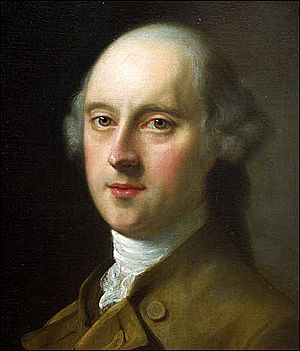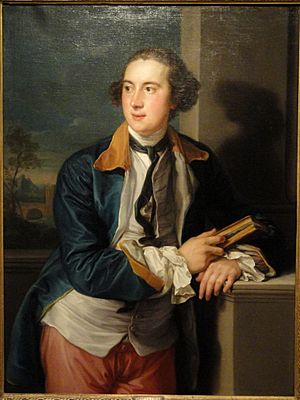William Legge, 2nd Earl of Dartmouth facts for kids
Quick facts for kids
The Earl of Dartmouth
|
|
|---|---|

The Earl of Dartmouth, by Nathaniel Hone
|
|
| First Lord of Trade | |
| In office 20 July 1765 – 16 August 1766 |
|
| Monarch | George III |
| Prime Minister | The Marquess of Rockingham |
| Preceded by | The Earl of Hillsborough |
| Succeeded by | The Earl of Hillsborough |
| Secretary of State for the Colonies and First Lord of Trade | |
| In office 27 August 1772 – 10 November 1775 |
|
| Monarch | George III |
| Prime Minister | Lord North |
| Preceded by | The Earl of Hillsborough |
| Succeeded by | Lord George Germain |
| Personal details | |
| Born | 20 June 1731 |
| Died | 15 July 1801 (aged 70) |
| Nationality | British |
| Spouse | Frances Nicoll (d. 1805) |
| Signature | |
William Legge, 2nd Earl of Dartmouth (born June 20, 1731 – died July 15, 1801) was an important British politician. He is best known because Dartmouth College in the United States was named after him. He held important government jobs, like being in charge of the British colonies.
Contents
Early Life and Family Background
William Legge was born in 1731. His father, George Legge, Viscount Lewisham, passed away when William was only one year old. William's mother was Elizabeth Kaye.
He went to Trinity College, Oxford, in 1748. In 1750, when he was 19, he became the Earl of Dartmouth after his grandfather died. This meant he inherited a special title and responsibilities.

Political Career and Influence
Lord Dartmouth was a key figure in the British government. From 1772 to 1775, he served as the Secretary of State for the Colonies. This meant he was responsible for managing Britain's territories overseas, especially in America.
His arrival in the American colonies was even celebrated by Phillis Wheatley, a famous poet. She wrote a poem called "To the Right Honourable William, Earl of Dartmouth" in his honor.
Lord Dartmouth also played a role in the life of John Newton, who wrote the famous hymn "Amazing Grace". In 1764, Lord Dartmouth suggested that Newton become a priest. He helped Newton get accepted into the Anglican ministry.
He also discussed trade rules with Sir William Johnson, 1st Baronet, who was in charge of Native American affairs in America. Lord Dartmouth understood the challenges of creating new trade rules. However, he noted that the colonies often disagreed on how to handle these regulations.
Supporting Good Causes
Lord Dartmouth was known for his generous spirit and support for various charities. He was a major supporter of the English trust that helped create the Moor's Charity School. This school, founded by Eleazar Wheelock in Lebanon, Connecticut, aimed to educate Native American children.
Later, Wheelock started Dartmouth College in Hanover, New Hampshire. He named the college after Lord Dartmouth, hoping to get his financial help. However, Lord Dartmouth did not provide money for the new college.
In London, Lord Dartmouth supported the Foundling Hospital. This was a charity that cared for abandoned children. He was a vice-president of the hospital from 1755 until he passed away. The famous painter Sir Joshua Reynolds even painted a portrait of Lord Dartmouth and gave it to the hospital. You can still see this painting today at the Foundling Museum in London.
In 1754, he became a Fellow of the Royal Society, which is a group of important scientists.
Family Life
Lord Dartmouth married Frances Catherine Nicholl on January 11, 1755. They had nine children together. Their children included:
- George Legge, 3rd Earl of Dartmouth (born 1755, died 1810)
- Hon William Legge (born 1757)
- Hon Charles Gounter Legge (born 1759)
- Hon Heneage Legge (born 1761)
- Hon Henry Legge (born 1765, died 1844)
- Admiral the Hon Sir Arthur Kaye Legge (born 1766, died 1835)
- Rt Rev and Hon Edward Legge (born 1767, died 1827), who became the Bishop of Oxford
- The Ven and Hon Augustus George Legge (born 1773, died 1828)
- Lady Charlotte Legge (born 1774, died 1848), who married Charles Duncombe, 1st Baron Feversham
Later Years and Legacy
Lord Dartmouth passed away on July 15, 1801, at the age of 70. He was buried in Trinity Church in the Minories in London.
His oldest son, George, became the 3rd Earl of Dartmouth after him. Lady Dartmouth passed away in 1805. The family lived at Sandwell Hall, which is no longer standing today.
Images for kids

